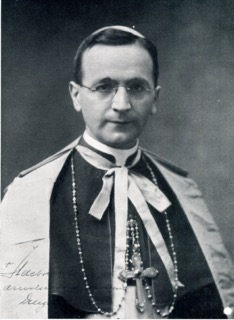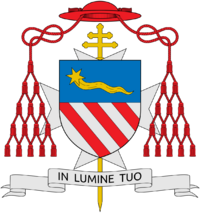Ildebrando Antoniutti facts for kids
Quick facts for kids Ildebrando Antoniutti |
|
|---|---|
| Prefect Emeritus of the Congregation for Religious and Secular Institutes | |
 |
|
| Church | Roman Catholic Church |
| Appointed | 26 July 1963 |
| Reign ended | 13 September 1973 |
| Predecessor | Valerio Valeri |
| Successor | Arturo Tabera Araoz |
| Other posts |
|
| Orders | |
| Ordination | 5 December 1920 |
| Consecration | 29 June 1936 by Pietro Fumasoni Biondi |
| Created Cardinal | 19 March 1962 |
| Rank | Cardinal-Priest (1962–73) Cardinal-Bishop (1973–74) |
| Personal details | |
| Birth name | Ildebrando Antoniutti |
| Born | 3 August 1898 Nimis, Kingdom of Italy |
| Died | 1 August 1974 (aged 75) Bologna, Italy |
| Buried | Santi Gervasio e Protasio, Udine, Italy |
| Parents | Giuseppe Antoniutti Anna Comelli |
| Previous post |
|
| Alma mater |
|
| Motto | In lumine Tuo |
| Coat of arms |  |
| Styles of Ildebrando Antoniutti |
|
|---|---|
 |
|
| Reference style | His Eminence |
| Spoken style | Your Eminence |
| Informal style | Cardinal |
| See | Velletri-Segni (suburbicarian) |
Ildebrando Antoniutti (born August 3, 1898 – died August 1, 1974) was an important Italian cardinal in the Roman Catholic Church. He was the head of the Congregation for Religious from 1963 to 1973. Pope John XXIII made him a cardinal in 1962.
Contents
His Early Life and Schooling
Ildebrando Antoniutti was born in Nimis, Italy, on August 3, 1898. He was the sixth of seven children. He studied at special schools called seminaries in Cividale and Udine.
During World War I, he often went with Archbishop Antonio Anastasio Rossi to visit military hospitals. He also visited churches in areas taken over by Austro-Hungarian forces. In November 1917, Antoniutti moved to Rome. There, he studied at the Pontifical Roman Seminary and the Pontifical Lateran University. By July 1920, he had earned advanced degrees in philosophy, theology, and church law.
Becoming a Priest
Archbishop Rossi made Antoniutti a priest on December 5, 1920. From 1921 to 1927, Antoniutti taught at the Udine seminary. During this time, he also worked as Archbishop Rossi's private secretary.
Early Church Roles
In 1927, Antoniutti became a secretary for the Pope's representative (called an apostolic delegation) in China. He worked under Archbishop Celso Costantini. By 1930, he became an auditor, and in 1933, he was a temporary leader (chargé d'affaires).
He was given the special title of Privy Chamberlain of His Holiness on September 24, 1931. In 1934, he became an auditor for the Pope's office in Portugal.
Serving as a Bishop
On May 19, 1936, Pope Pius XI chose Antoniutti to be the Pope's representative (Apostolic Delegate) to Albania. He was also named a Titular Archbishop of Synnada in Phrygia. This means he was a bishop for a historical area.
He became a bishop on June 29, 1936. Cardinal Pietro Fumasoni Biondi led the ceremony. Archbishop Rossi and Archbishop Costantini also helped.
Antoniutti stayed as Albania's apostolic delegate until August 1936. On July 25, 1937, he was sent by the Pope to Spain during its civil war. His job was to help exchange prisoners and assist priests who had fled from certain areas. On September 21, he became the temporary leader for the Nationalist government in Spain.
Later, on July 14, 1938, Antoniutti became the Pope's representative to Canada. While in Ottawa, he had some disagreements with a magazine editor. He also oversaw the resignation of Archbishop Joseph Charbonneau.
His Time as a Cardinal
Antoniutti was named the Pope's official representative (Nuncio) to Spain on October 21, 1953. Pope John XXIII made him a Cardinal-Priest on March 19, 1962. His church in Rome was S. Sebastiano alle Catacombe.
From 1962 to 1965, he attended the Second Vatican Council. This was a very important meeting for the Catholic Church. He also helped choose the next Pope in 1963. This process is called a papal conclave. He was one of the cardinals who voted for Pope Paul VI.
On July 26, 1963, Pope Paul VI appointed Antoniutti to a high position in the Roman Curia (the Pope's administration). He became the Prefect of the Congregation for Religious. This group oversees religious orders.
After ten years, Cardinal Antoniutti stepped down from this role. On September 13, 1973, he became a Cardinal-Bishop of Velletri-Segni. The next year, he was named the Camerlengo of the College of Cardinals. This is a special role that helps manage the cardinals.
His Final Years
Cardinal Antoniutti wanted to rest in his hometown of Nimis. He left Rome on August 1, 1974. Sadly, he was killed instantly when his car hit another vehicle on a bypass near Bologna.
His body was brought to Nimis two days later, on what would have been his seventy-sixth birthday. A funeral Mass was held at the parish church. Cardinals Ermenegildo Florit and Albino Luciani (who later became Pope John Paul I) and nine other bishops attended. Antoniutti is buried at the parish church in Nimis.
Interesting Facts
- When he was the Pope's representative in Spain, Archbishop Antoniutti praised a church group in Seville. They had spoken out against false claims about him and other church leaders.
- Some people believed Cardinal Antoniutti was a good choice for Pope during the 1963 election. He reportedly received about twenty votes.
- After Pope Paul VI was elected, he asked Antoniutti to "be a brother and a friend to me." Antoniutti replied, "I will always be respectful to the pope."

